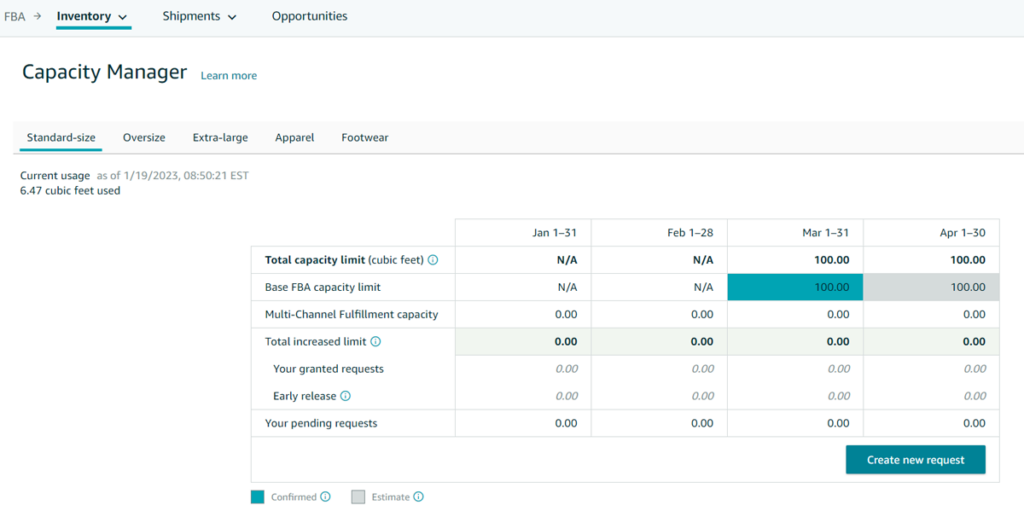All sellers must know about the new Amazon FBA capacity limits system. Over the past few years, Amazon has changed its FBA storage limits a few times. These changes confused and frustrated sellers as they would restrict or decrease the amount of inventory FBA sellers can dispatch to Amazon’s fulfillment centers.
Until recently, Amazon had weekly restocking and quarterly storage volume limits. But in March of 2023, Amazon removed the weekly restock and quarterly storage volume limits and replaced them with a monthly capacity limit, called FBA capacity limits.
What are FBA capacity limits?
FBA capacity limits are monthly limits determining how much inventory sellers can send and store at Amazon. The new capacity limits will give most sellers more inventory capacity and control than the previous FBA inventory storage and restock limits.
Amazon sets FBA capacity limits during the third week of each month. Additionally, Amazon includes your limits for the upcoming month and an estimate for the following two months. Allowing you to plan your inventory in advance. Capacity limits are measured by volume in cubic feet. Your capacity is based on account type. Sellers will receive one capacity limit for each type of storage used. The limit is fifteen cubic feet if you have an individual selling account. Active professional sellers with Amazon for over 39 weeks, capacity limits will be based on your Inventory Performace Index (IPI) and sales performance.
The higher your IPI score is, the higher your capacity limits will be.

Influencing factors of your IPI score
- Excess inventory: Avoid storing stagnant inventory that is not selling and accumulating monthly storage fees.
- Sell-through rate: You want this to be as high as possible. The sell-through rate is determined by sold and shipped units over the past ninety days divided by the average number of units in stock in fulfillment centers.
- In-stock rate: Keep fast-selling items in stock as much as feasible.
- Stranded inventory: Stranded inventory is when you have products accumulated in Amazon’s fulfillment centers but no active offer for the product. Keep this as low as possible.
FBA capacity limits considerations
- Inventory Performance Index (IPI) Score: Amazon introduced the IPI score to measure how efficiently and effectively a seller manages their FBA inventory. A higher IPI score can grant the seller more storage space, while a lower score may result in storage limits. This encourages sellers to maintain a balanced inventory, avoiding excess stock that doesn’t sell.
- Storage Limits: Amazon FBA has storage limits based on volume (in cubic feet) for standard-size and oversize items. These limits can be seasonally adjusted and may be influenced by a seller’s sales performance and history.
- Restricted Products: Some products are restricted or require approval before they can be sent to FBA due to their nature (e.g., hazardous materials, perishables).
- Long-term Storage Fees: To encourage sellers to keep their inventory moving, Amazon might charge long-term storage fees for items that have been in an FBA warehouse for over 365 days.
- Temporary Adjustments: During certain times, like the holiday season, Amazon might impose additional restrictions to accommodate the surge in demand. For example, in the past, there have been periods where only items with a certain sales velocity were allowed to be sent to FBA to ensure fast-moving stock gets priority.
- FBA Storage Types: Amazon has different storage categories like standard, oversize, apparel, footwear, flammable, aerosol, and refrigerated. Each type might have its own set of rules and limitations.
It’s crucial for FBA sellers to stay updated on Amazon’s policies and rules. They can do this by regularly checking the official Amazon Seller Central portal or the FBA section of Amazon’s website.
However, if you’re seeking the most current details on FBA capacity limits or if there have been any recent changes, I’d recommend checking directly with Amazon’s official resources or reaching out to their support for the latest information.
How FBA capacity limits affect Amazon sellers
This change now gives sellers a more precise understanding of how much inventory they can send per storage type to Amazon. Amazon states this change will provide most sellers with more significant capacity limits. If you sell through your current inventory fast, Amazon will award you more storage capacity.
Amazon FBA (Fulfillment by Amazon) capacity limits can have a range of effects on Amazon sellers. While the specific impacts can vary based on individual seller circumstances, the following outlines some general ways these limits can affect sellers:
- Inventory Management Challenges: Sellers might need to be more vigilant in tracking their inventory levels, ensuring they stay within the allotted storage space. They’ll have to employ better forecasting methods and avoid overstocking slow-moving products.
- Increased Storage Costs: When products stay in Amazon’s warehouse for too long, especially past certain thresholds like 180 days or 365 days, sellers may incur long-term storage fees, eroding profit margins.
- Potential for Stockouts: With capacity limits, there’s the risk of running out of stock, especially during peak sales. Stockouts can result in lost sales and negatively impact a product’s ranking on Amazon.
- Strain on Cash Flow: Holding inventory, especially if it’s not selling quickly, can tie up cash. With storage limits, sellers might be less willing to purchase in bulk (which often comes with discounts) out of fear of incurring long-term storage fees.
- Operational Complexities: Sellers might need to coordinate with multiple fulfillment centers or third-party logistics providers to handle their inventory needs, adding complexity to their operations.
- Adoption of a Hybrid Strategy: Due to these limits, some sellers adopt a hybrid approach, using both FBA and FBM (Fulfillment by Merchant). While FBA handles most sales, FBM can be a backup during peak periods or when nearing storage limits.
- Shift in Product Selection: Sellers might be incentivized to focus on fast-moving products and reduce the number of slow-moving SKUs in their portfolio to optimize storage space usage.
- Increased Focus on Inventory Turnover: To optimize storage space and avoid additional fees, sellers might focus more on improving their inventory turnover rate, which means selling through their inventory faster.
- Possible Increase in Product Prices: Some sellers might increase product prices to compensate for additional costs associated with storage fees or the need to use alternative, possibly more expensive, storage and fulfillment solutions.
- Impact on New Sellers: New or smaller sellers who still need to build a strong sales history may need help navigating the capacity limits and scaling their businesses on the platform.
- Need for Continuous Monitoring: Amazon’s IPI (Inventory Performance Index) and other metrics become even more crucial. Sellers must monitor these metrics closely to ensure they are in good standing and eligible for maximum storage space.
- Strategic Promotions and Discounts: Sellers might employ strategic promotions, lightning deals, or discounts to clear out excess inventory or items nearing the long-term storage fee threshold.
While FBA capacity limits are meant to optimize Amazon’s warehouse space and ensure efficient operations, they pose challenges for sellers. Successful navigation of these limits often requires sellers to be proactive, strategic, and flexible in their inventory management and sales approach.
Additionally, you can bid on more storage capacity if you require more room for a new product launch or other products. Performance credits could help with this cost. If your products sell through, you will not need to pay these fees.

